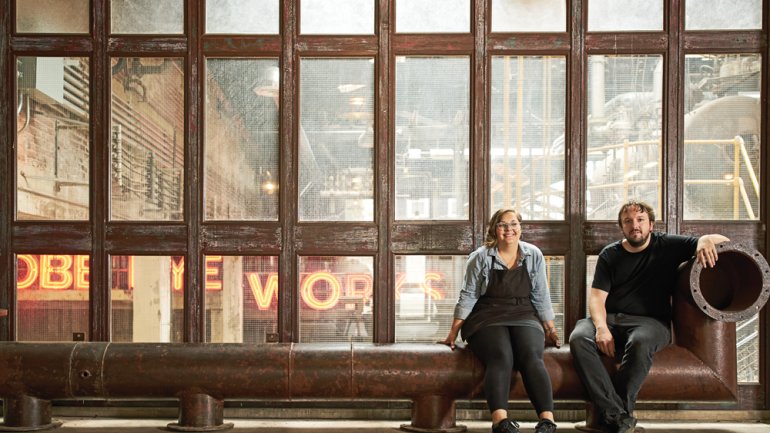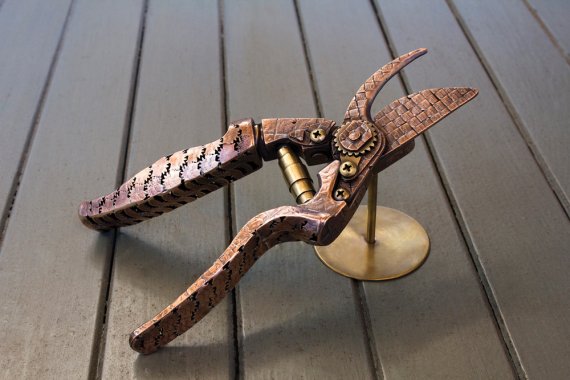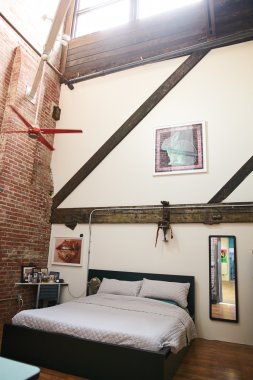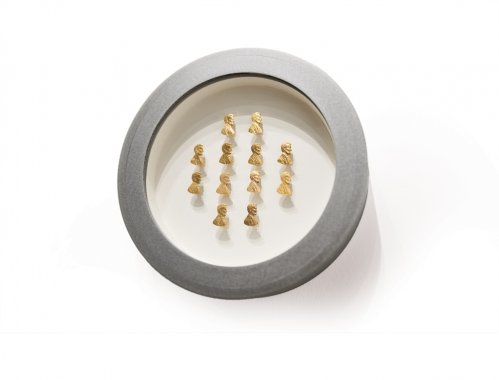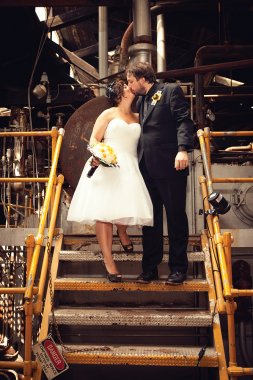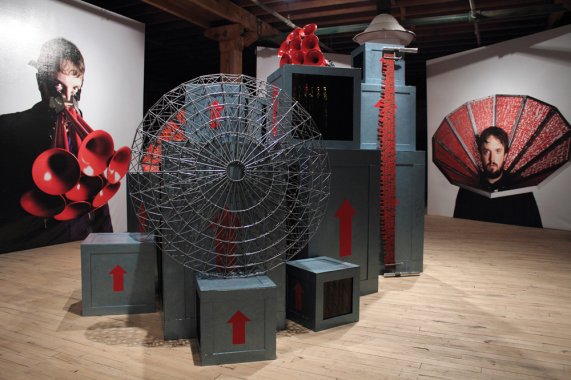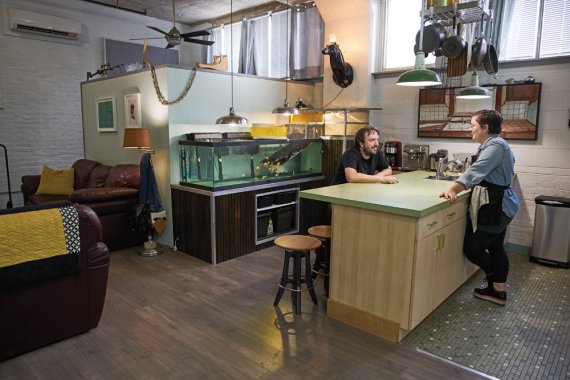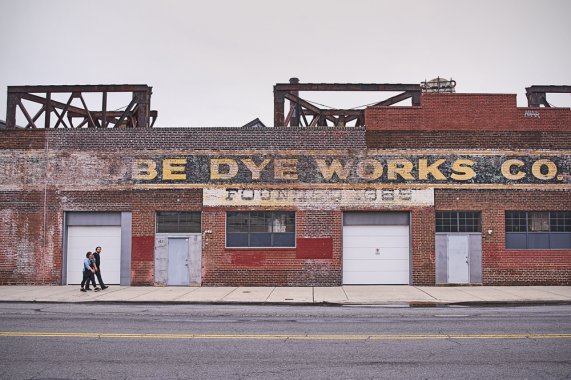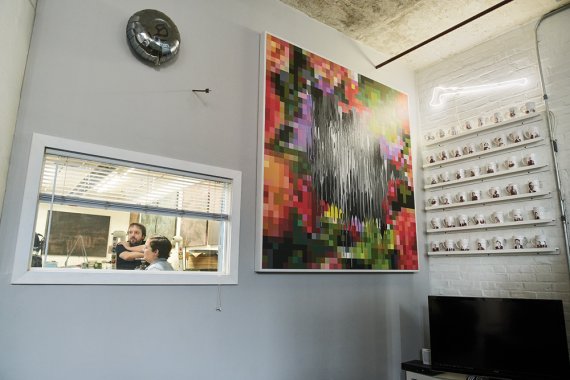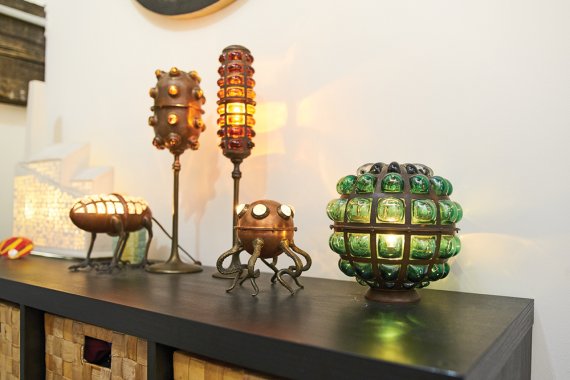Home Makers
Home Makers
Artists Stacey Lee Webber and Joseph Leroux have gone all-in on Globe Dye Works. The artists live, work, and even got married at the 145,000-square-foot complex, a collection of 10 industrial buildings in Philadelphia’s Frankford neighborhood. Much of Webber’s artistic practice – she is best known for jewelry and objects using altered currency, including impeccable renderings of tools from the world of industry – echoes in the history of her home. Established in 1865, Globe Dye Works was a hub for the dyeing and bleaching industries until it closed in 2005; remnants of that work remain here, including enormous dye vats and spools of thread in every color of the rainbow.
The building didn’t lie dormant for long: In 2007, new owners began to rehab and reimagine the space. They envisioned the building as headquarters for artists, designers, and entrepreneurs – emerging and established – who are deeply connected to Philadelphia’s creative scene. As two of the first occupants, Webber, 36, and Leroux, 34, have worked tirelessly to build a life, a community, and a business within the walls of their 3,500-square-foot live-work space. We asked Webber to tell us how it all works.
How did you come to Globe Dye Works?
We’ve been here 7½ years, and it’s evolved a lot. We met in Madison, Wisconsin, and followed our friend Matthias Pliessnig, who makes steam-bent furniture, to Philly. A year later, two of the owners of Globe Dye Works came to a studio party. They actually found us through the artist Donald Lipski, who had lived in Philly and liked my work; he’s done coin benches, public art with tokens. He connected us with one of the owners.
Were you immediately excited about the space? Or did it take time to warm up to the idea?
The building was so different then. It was definitely a work in progress. We’d visited the building initially before moving out here, and we weren’t sure about it. We would have been two of the first five people and thought we might need a little more community than that in a new city. A year later, we thought we should give it a shot. More people had moved in, it’s so beautiful here, and the owners were so supportive of our work. They just kind of hooked us. We love the other people in the building: metalsmith Ken Derengowski, whom we know from Madison, Weckerly’s ice cream, Rival Bros. Coffee. We met Brian Giniewski when he was in the [Hip Pop] emerging artists section at an ACC show, and he has his studio here now. We grill with people in the building almost every night when it’s nice out, and they’re almost like an alternative family. It’s fun to think about who could move in next.
What are the biggest rewards and challenges of living where you work and working where you live?
Having our living and working spaces together was always our vision, mostly just for efficiency. We knew it would take our full being if we wanted to make this work as a career, and we’ve only been full time for about two or three years now. Up until then, we had part-time jobs, burning the midnight oil, and you had to get into the studio with any time you could spare. Honestly, this kind of setup is all we’ve ever known. If I have 100 things to do and could do them by staying up 24 hours a day, I kind of try.
Have the architecture and history of these spaces affected the work you make?
Definitely. The “raw building” feel, the brick-and-concrete aesthetic – I think we already have that ingrained in us naturally, but it definitely comes out more being here. History is everywhere. Our bathroom used to be the women’s locker room for the workers at the factory, and our bedroom is carved out of one of the original dye houses. There were different dye rooms for different colors, and cranes over the whole space, which has a sawtooth roof with a series of ridges to allow light into the factory. We got married in the boiler room five years ago.
They’ve done such a nice job keeping the character of the space that we’ve just kept doubling down on being here. We just signed a three-year lease.
Little [art] pieces seem even tinier living in this giant building, so your mind opens to ideas of scale, texture, and materials. We get calls from other people in the building looking to use our tools, we’ve set up our shop to be able to make anything – it’s kind of like how you might set up a kitchen. We have a metals area with my bench and my coin drawer, a woodworking area, and a welding area with good tools. Building that has been a continuous process. At this point, it would take several tractor-trailers to move everything out of this building. When we moved here, everything fit in one small area of the studio. We thought we had so much space. We’ve had a lot of room to grow.
Your living area is filled with artwork. How do you decide which pieces you want to come home to?
We made a clear decision to have only other people’s work in the living space; it’s one of our separation tactics. The biggest piece that we bought together is by Morgan Sims from Chicago. We love the color. We have another piece by him in the bedroom, and when we like artists, we really go all-in. There’s a piece by Mike Rea, whom we know from Madison, who makes these giant wooden robots. We know pretty quickly when we want to live with something.
When we have a successful show, we might try to buy something for our home. Most of our collection comes from trades at shows – these Nicole Aquillano and Ani Kasten vessels, for example.
One of the best things we’ve done is put up two new walls in the working space to create our gallery, Bertrand Productions – a really clean space between two studios. We’ve been able to bring other people into our space to have shows lasting about a month. We get to live with that work for a small amount of time, and we can take the same money we used to buy one piece with and support people we think are doing really cool things.
I covet Mallory Weston’s work, which we’ve shown. We just got this image of a piece that was in our last show: an astronaut wearing a 24-karat gold mask by Aidan Rumack, who also has a space at Globe. And the next show is with Mark Wagner, whom I’ve collaborated with and whose work I definitely covet.
How do you feel living here now that it’s become a destination for so many people?
It’s great. We have a high school group in Washington, DC, that comes up once a year to visit the studio. We have collectors over all the time; everyone wants to visit the building.
One morning we weren’t even awake yet, and we got a call that our local political representative was here. There are no inherent boundaries; I thought it was a big deal to get a bedroom with a door!
